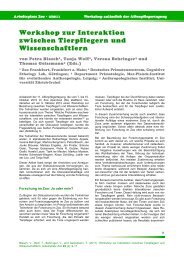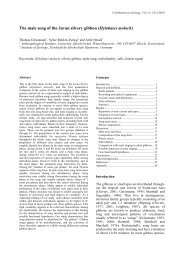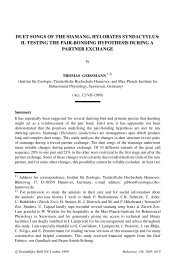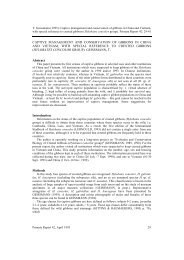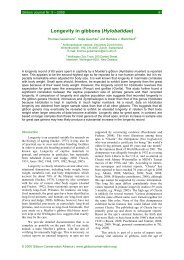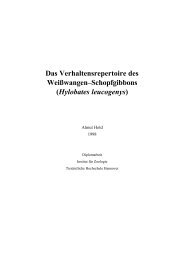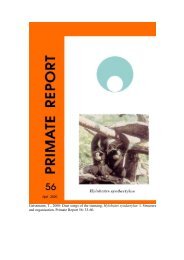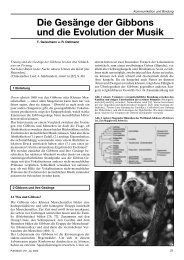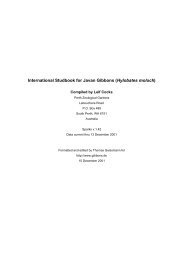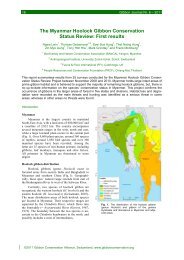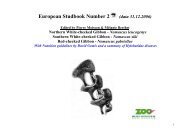How To Tape-Record Primate Vocalisations - Gibbon Research Lab
How To Tape-Record Primate Vocalisations - Gibbon Research Lab
How To Tape-Record Primate Vocalisations - Gibbon Research Lab
- No tags were found...
Create successful ePaper yourself
Turn your PDF publications into a flip-book with our unique Google optimized e-Paper software.
Geissmann: <strong>How</strong> to <strong>Tape</strong>-<strong>Record</strong> <strong>Primate</strong> <strong>Vocalisations</strong> 9after you have spent hours tape-recording background noise, thus expiring all yourrechargeable batteries. In such cases, an emergency set of batteries will come handy.UltrasoundA number of small primates (e.g. Cebuella, Galago, Microcebus, Nycticebus) have beenshown to emit ultrasound vocalisations above 20 kHz (Cherry et al. 1987; Glatston 1979;Pariente 1974; Pola & Snowdon 1975; Zietemann 2000; Zimmermann 1981). Fundamentalfrequencies of some note types of Microcebus murinus were reaching maximum values ofabout 45 kHz (Zietemann 2000). Because detecting, recording and analysing ultrasoundvocalisations requires special equipment, such calls may be more widespread among smallprimates (and other small mammals) than has been documented, so far. Fortunately, muchresearch is being carried out on ultrasound calls of bats, and scientists wishing to studyultrasound vocalisations of primates can greatly benefit from exploring the expertise of, andthe technologies being used by, bat researchers.Bat detectorsBat detectors or ultrasound detectors were developed to provide researchers withinstruments to study bat echolocation, but are also used for research on other small mammalsand grasshoppers. Bat detectors are based on both analog and digital techniques to detect andrecord ultrasounds and transform them into audible sounds. The detectors available on themarket use three main systems: heterodyne frequency shifting, frequency division and timeexpansion. The most advanced instruments make use of all these three systems to makeultrasounds audible and recordable, with some limitations, on usual audio recorders.Heterodyne detectors and frequency division (or count-down) detectors are real timemethods (i.e. you hear the sound from the detector at the same time as it is emitted by thebat). They are useful for quick yes/no statements of bat activity. They allow recording anaudible representation of an ultrasonic call, not of the full ultrasonic signal structure.If you want to study the frequency spectrograms, you have to use a time expansiondetector (Petterson D980: $3,500; Ultra Sound Advice: U30 + PUSP: $2,867). The timeexpansion detector is the most accurate system: it retains all information of the originalsignal. The method is similar to making a high speed tape recording of the sound and thenplaying it back at a lower speed. But instead of using a huge traditional high speed taperecorder,the ultrasonic signal is sampled at high speed, then replayed at a lower sample rate,e.g. one tenth, to be made audible and stored in this format on a tape-recorder. If the signal isstored at a sample rate ten times lower than the original one, frequencies are reduced by tenwhile time is expanded by the same factor.Clearly this is not a real time conversion method, but it does offer a number of benefitsover and above these methods. Since the signal is stretched out in time, it is possible to hear



